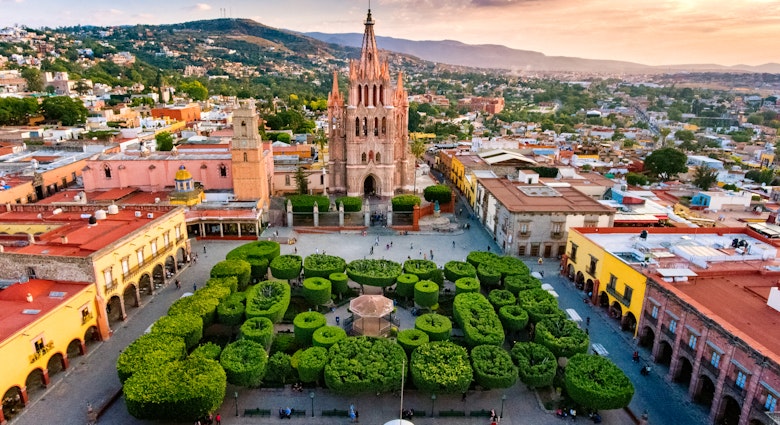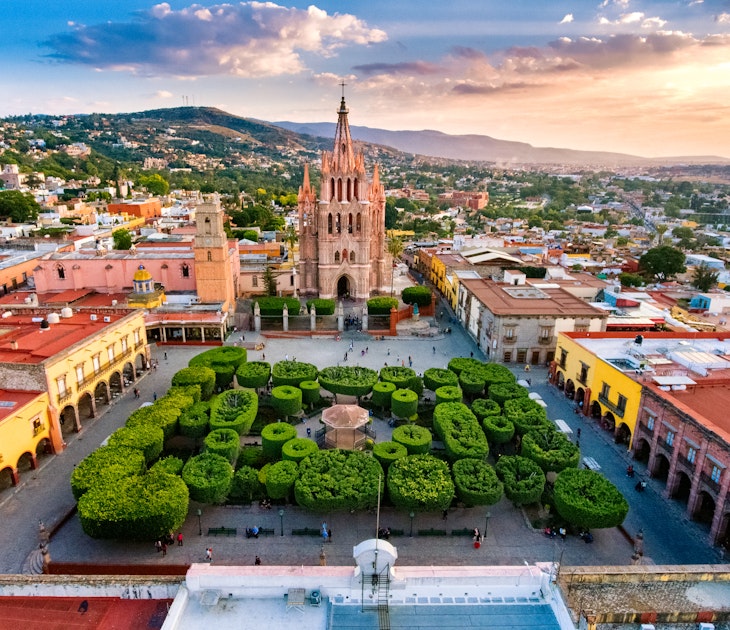
Slow down and experience Mexican culture in the beachy town of Zihuatanejo
Mar 9, 2022 • 10 min read

Learning to surf is just one of Zihuatanejo's many things to do © Carolin Voelker / Getty Images
On the Pacific coast of Mexico in the state of Guerrero, there's a destination where colorful buildings cascade down the slopes of the Sierra Madre del Sur Mountains, along the curve of calm bays and white sandy beaches – a charming town called Zihuatanejo.
In the 1970s, Zihuatanejo – which translates to ‘place of women’ in Nahuatl – was a more low-key getaway than its nearby neighbor, Ixtapa, and attracted the likes of Andy Warhol, John Wayne, Liz Taylor and Mick Jagger. Today too, travelers tired of the crowded, resort-heavy destinations in the Yucatan and Baja Peninsula make their way to Zihuatanejo in search of something different – a place where they can easily delve into the culture, community and nature.
The beauty of Zihua, as most people call it, is found in the warm waters along its four beaches, in the restaurants in town and on the boardwalk. It’s in these places that tourists and locals mingle, because Zihua isn’t like other coastal Mexican destinations where the two are separated – here, they connect.
Best things to do in Zijuatanejo
While resort culture abounds in many coastal Mexican cities, Zihuatanejo has maintained its individuality, and there are as many Mexican travelers here as locals and foreigners.
Walk the boardwalk
The city’s boardwalk, Paseo del Pescador (Fishermen’s Passage), is the town gathering place: fishers bring their catch to sell in the morning, and people come to purchase – or at least marvel – over the day’s haul.
On any given day you’ll see cyclists, photographers, people playing basketball and even dance classes in session. Be sure to stop for a break and have a cafecito on one of the patios, perhaps at Café Marina.
Have pozole on a Thursday
If there is one thing you should keep in mind when booking a trip to Zihua, it’s Pozole Thursday. Every Thursday from 2pm to 5pm, people line up at the city’s pozolerias – restaurants that serve bowls of green pozole, a type of soup with hominy and chicken. (Pozole is typically red; Guerrero is the only state in Mexico where it is green.) La Casa Vieja is one of the best pozolerias in town. Expect a line, so get there early.

Hit the beach
Zihua’s warm waters don’t generally dip below 65°F, which makes swimming and relaxing on the beach just about perfect.
There are four beaches here to explore. Playa Municipal (also known as Playa Principal) and Playa Madera are located near the city center; Playa Municipal is where fishers moor their boats when they’re not out to sea, so Playa Madera is the better option of the two. Playa La Ropa is the largest and our personal favorite. However, if you’re feeling intrepid, take a boat ride to Las Gatas, a lovely white-sand beach without vegetation, situated on a shallow cove with clear blue waters that's lined with open-air restaurants serving fresh seafood and cervezas.

Sail the bay
A boating excursion is a great way to explore the Zihua coast. You can rent a sailboat to explore the bay, a party boat for you and your friends, a luxurious yacht or something more suited to an all-day sportfishing trip.
Picante is the best option for catamaran experiences, especially at sunset; it also offers whale-watching boat tours between December and March. To reel in marlin, mahimahi, tuna, wahoo and sailfish, book a fishing excursion with Gran Jefe II. Yates Ixtapa and Luxury Yacht Rentals both have luxe boat rentals and customizable charters available.
In February, don’t miss the city’s annual SailFest, a sailboat festival created to raise money for local education and children’s services. The deluge of white sails on the ocean is a sight to behold from the hotels, boardwalk, and beaches of Zihua.
Explore under the sea
Scuba diving and snorkeling are two of the most popular activities in Zihuatanejo, thanks to a mix of shallow reefs, caverns, sunken ships and abundant biodiversity. The water is teeming with angelfish, crabs, starfish, stingrays, octopus, manta rays, sharks and seahorses. Sightings of sea turtles are likely year-round, but your chances are even higher between June and October. Whales migrate to the area between December and April, and seals make an appearance between August and October.
Snorkeling is best experienced at Manzanillo Playa, Caleta del Chon, Zacotoso and Playa Coral on Ixtapa Island. You can even snorkel around the coral in the shallow clear bay at Playa Las Gatas. Equipment can be rented from various little shacks on the beach.
Fans of scuba diving will discover that Zihua waters are warm, generally have good visibility and lack any type of currents, which is nice for beginners. The best time to dive is between November and May, and there are dozens of dive sites in the area, Morros de Potosi being an especially popular destination. Above water you’ll see granite rocky islets, but under the sea is a mesmerizing world of caverns, coral, valleys and depths of up to 100ft.
Dive Zihua and Adventure Divers Zihuatanejo stand out among outfitters and have great online reviews.
Take a surf class
Less than a 40-minute drive away, the nearby towns of Saladitas and Troncones are beloved surf spots. Swells are biggest from April to October, but you can still enjoy chest-high waves with great shapes from November to March.
Troncones is better suited for seasoned surfers, though many seek out Saladitas to ride what may be the longest left wave in the country.
If you’re a beginner or want to brush up on your skills, take a class in Saladitas with brothers and long-time local surfers Edgar and Leon of Catcha L’ola. They’ll guide you to part of the beach and ocean away from experienced surfers, so you can learn the ropes without any pressure.

My favorite thing to do in Zihuatanejo is enjoying the seafood
To really get to know a culture and a community, you have to eat their food, and in Zihuatanejo, seafood reigns supreme.
The city has always been a fishing village, and that didn’t change much when tourism began to develop in the 1970s. Each morning at sunrise, fishers return to Playa Principal, their small boats bearing big catches. At the Fishermen’s Market, they set out fish on sheets and in ice chests. Chefs and citizens arrive in the early hours to buy what they need to cook that day.
You’ll be hard-pressed to find a restaurant in town that doesn’t sell seafood for an affordable price. And Zihua's diversity of seafood is phenomenal. Pacific sailfish weighing up to 175lbs and 400lb black and blue marlins aren’t unheard of, and yellowfin tuna, dorado, roosterfish, grouper, Spanish mackerel, wahoo, bonito and barracuda are all common to the area too.
If you go on a fishing excursion, ask your guide which restaurants will clean and serve up your catch. Otherwise, make sure to try some of the local seafood specialties like tiritas de pescado. Zihuans cut fish into small strips (traditionally sailfish or skipjack, though other types may be used), marinate it in lime juice and serve it on a cracker. Depending on where you go, it may also be dressed with onions, chilies, avocado, peppers or cilantro.
Seafood may be the most dominant type of food in Zihua, but there are other regional specialties to try – like costillas de puerco, or pork ribs in a red sauce, at Carmelitas Café.
Budget and costs in Zihuatanejo
Zihuatanejo isn’t just a beautiful destination, it’s affordable too. Whether it's coffee or beer, drinks are typically less than $2. You can enjoy fresh seafood meals for less than US$15 – and in fact, that’s on the high end. At the popular Mariscos El Gabo, the average seafood entree is about $7.
It's also cheap to get around: taxi rides don't usually cost more than $5, and buses are only $0.50 to $1. The boat ride to Playa Las Gatas is less than $4.
The most expensive aspect of a trip to Zihuatanejo is going to be your hotel, but you should be able to find one that fits your budget. An entire vacation-rental unit in Zihua costs $29 to $190 per night, while hotels go for $100 to $200 per night. You can find some budget-friendly rooms for $50 per night, though the closer they are to the beach, the more expensive they seem to be.

Beachfront hotels in Zihua
Most people who travel to a coastal destination – especially in Mexico – want a beachfront hotel. The lure of the ocean and the white sandy beach is enough to spend a few extra bucks. And when you're scoping out Zihuatanejo on a map, it may seem like there are a number of properties right on the water. But because Zihua is set on the slope of a mountain, many hotels and restaurants that look beachfront on paper actually aren't – a staircase takes guests down to the beach.
Of the four beaches, Playa La Ropa is the only one with beachfront hotels – and it doesn't have many to choose from. The best by far is the Thompson Zihuatanejo. It has the service, design and amenities you expect of the brand and the perfect location on Playa La Ropa.
You can see the ocean from the resort’s pools and stylish suites, and enjoy the sand between your toes as you dine at its two restaurants, Ceniza and Hao. Plus, the Zihuantanejo baby turtle release – which happens as the sun sets over the ocean – occurs on the beach right in front of the hotel. Though it's a 25- to 35-minute walk from the city center, it’s well worth it to have direct access to this swimmable bay.
The best time to go to Zihuatanejo
Travelers to Zihuantanejo will enjoy temperatures in the 80°F range year-round, which is why many US travelers visit during the winter, and why the region’s high season is from October to June.
July to September is Zihua’s rainy season, September being the wettest month of the year (and April the driest). That said, rain tends to fall in the evenings or at night, so you can generally enjoy a lot of sun during the day. Just keep in mind that hotter temperatures and rainfall can create some humidity.
Because the weather is pretty consistent throughout the year, hotel prices don’t seem to change dramatically. However, like most places in Mexico, prices may increase around holidays and festivals, like SailFest in late February, International Guitar Festival in March, International Sports Fishing Contest in May and Zihua’s municipality anniversary, which falls during the winter holidays.
Getting around in Zihuatanejo
From Zihuatanejo International Airport, it’s a 15-minute drive to the city center. If you're planning to explore the surrounding areas, you could rent a car for a day or two, but otherwise it's quite easy to get around on foot.
Of course, some routes will be shorter than others, depending on where you stay. From Playa La Ropa, for example, it's a bit of a trek – the walk is hilly (remember, the city is on a mountain slope), but the views along the way are amazing.
If walking is not an option, don’t fret – taxis are plentiful. The city is not that large, so expect most rides to cost less than $4. A taxi from the airport to the city center is about $11, and Ixtapa is only a 15-minute drive away, so that trip should cost about the same. At night, there is a taxi surcharge, but it won’t put a dent in your pocket.
You can also take buses or microbuses from Zihuatanejo to the suburbs or Ixtapa. Bus tickets cost $0.50 to $1, making them the most inexpensive transportation option in Zihua.
You might also like:
Beach boho vibes without the crowds: why we love Mexico's Central Pacific Coast
The best places to visit in Mexico for culture, cuisine and cenotes
Top 19 absolutely unmissable experiences in Mexico
Explore related stories


 BeachesBeach boho vibes without the crowds: why we love Mexico's Central Pacific Coast
BeachesBeach boho vibes without the crowds: why we love Mexico's Central Pacific CoastNov 23, 2021 • 5 min read

 Wildlife & NatureDay trips from New Orleans: 9 can't-miss jaunts from The Big Easy
Wildlife & NatureDay trips from New Orleans: 9 can't-miss jaunts from The Big EasyNov 21, 2024 • 6 min read

 Wildlife & NatureHidden treasures: Where locals love to travel in Argentina
Wildlife & NatureHidden treasures: Where locals love to travel in ArgentinaNov 21, 2024 • 5 min read
